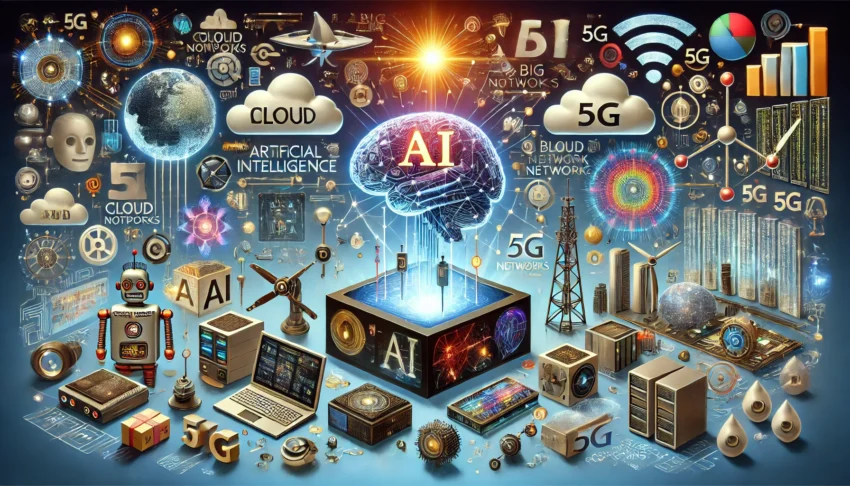The impact of technology cannot be overemphasized when discussing Artificial Intelligence (AI). From simple concepts to the modern intelligent systems, the progress of technology has played a vital role in the development of AI. This article outlines how various technological advancements have influenced AI and how they are likely to in the future.
Introduction to AI and Technology
Artificial intelligence can be described as a branch of computer science that deals with the ability of machines to perform tasks which require human-like intelligence. They range from basic activities such as pattern recognition to higher-order functions such as decision making, problem solving, or natural language processing. Still, technology wouldn’t have advanced so much as it has without the AI that it supports.
Technology is the enabler of AI in the sense that it offers the implements required for the refreshing of AI. If not for computers, storage and networks that have been improved AI would not have developed as it has been today. Advanced compute and storage, intelligent algorithms and software and availability of huge amount of data has brought Artificial Intelligence into mainstream.
Computing Power: The Core of the Impact of Technology on AI
Technology has influenced AI in various ways for instance, the enhancement of computing speed. Initially computers were slow and cannot process big data as compared to the present modern day computers. AI research was limited because the main processing machines could not support many programs.
In today’s modern world, we have supercomputers that can solve even large problems and work with large sets of data. Specific chips, such as GPUs (Graphics Processing Units) and chips designed specifically for AI, enable the training of AI models at a faster pace. This increase in computing power has been imperative in advancing the capabilities of AI.
For instance, deep learning, which is one of the branches of AI that functions like how human beings learn, requires data processing. Its advancement was due to GPUs that accelerated this process and deep learning started being used on a large scale.
Big Data: Fuel for AI’s Growth
Apart from computing power, another factor that has significantly contributed towards the advancement of AI is big data. Data is as crucial to an AI as food is to a human being—both are essential to learning. The popular AI researchers and key people of the AI growth have pointed out that in the past, there was a lack of information which could aid the ability of AI to improve. Yet, with the recent technology advancements such as the use of the internet and social media, a lot of data became accessible.
This information is utilized by AI systems, especially machine learning methods, to search for patterns and generate forecasts. For example, let’s imagine that you are as typing a search query on a search engine at some point; in this case, AI can learn from your query. The more the databases fed to AI, the better it becomes in providing you the right results. With help of big data AI was further developed and can be used in various fields such as health care, financial, and auto-mobile, examples being self-driving vehicles.
Cloud Computing: Making AI Accessible
Cloud computing is another large category of technologies that have made AI more feasible. It is the utilization of the Internet for computation, storage, and data transmission instead of utilizing in-house hardware. This innovation has been an opportunity for more individuals and corporations to leverage on AI.
Earlier, companies had to invest in servers and hardware to incorporate AI in their business processes, which was costly and only possible through cloud computing. Today however new platforms such as Google Cloud, Microsoft Azure and AWS allow organizations to rent the computational power they require. This means that the resources required in developing AI have been made accessible to anyone who has access to the internet thus making developers and even small businesses to develop complex AI systems.
Sensors and Robotics: Improving AI’s Real-World Applications
Sensors and Robotics have also enabled interaction of AI with the physical environment with the help of technology. Compared to human beings, robots and artificial intelligent systems are capable of gathering information on a real time basis and take decision on the same. For instance, self-driving vehicles rely on cameras and radars, and different sensors to drive the car.
In manufacturing industries the use of robotics has been increased to enhance production and minimize errors. Sensory input is another characteristic that is particularly useful since through it AI can learn new tasks in fields that it is involved in.
The Evolution of AI: From Simple to Complex Systems
AI in today’s world is different from that of the previous decade or the one before that. In the past, AI was limited to simple applications such as playing chess or providing mathematical solutions. Due to advancement in technology, today AI systems can perform much complex functions like identifying images, speech recognition and even prediction of diseases.
For instance, natural language processing (NLP) refers to the ability of a computer to process and interpret human language. Natural language processing helps devices such as Siri or Alexa to interpret vocal instructions and offer relevant responses. Most of these systems would not have been developed to their present state without enhancement of software and hardware.
Future Technologies That Will Shape the Impact of Technology on AI
Several new technologies will further advance AI in the future:
- Quantum Computing: These computers, though still in development, could process information much faster than today’s machines, allowing AI to solve complex problems more efficiently.
- 5G Networks: 5G will greatly increase data speeds, making it easier for AI systems to work in real-time environments like self-driving cars or remote surgeries.
- Edge Computing: This allows AI to process data closer to where it’s collected (e.g., on devices), improving real-time decision-making and reducing delays.
Ethical and Regulatory Concerns
As AI grows alongside technology, ethical and regulatory concerns also arise. People are discussing the proper use of AI. Issues like data privacy, algorithm bias, and job loss due to AI are important topics.
Regulating AI is tough because the technology is evolving faster than laws can keep up. As AI becomes a bigger part of daily life, clear guidelines for its use are becoming more necessary.
Conclusion
Technology has had a major impact on AI, from the early days of simple computers to the powerful systems we use today. As computing power, data access, cloud services, and new technologies like quantum computing continue to improve, AI will only become stronger and more integrated into our lives.
However, as AI advances, we must also pay attention to its ethical and social implications. By developing technologies responsibly, we can ensure that AI benefits everyone.
FAQ
How has technology changed AI over the years?
Technology has increased AI’s capabilities by providing faster computing power, access to large datasets, and advanced tools like cloud computing. This is allowing AI systems to perform more complex tasks than ever before.
Why is big data important for AI?
Big data provides AI with the necessary information to learn patterns and improve over time. Without large amounts of data, AI systems would struggle to make accurate predictions or learn from experience.
What role does cloud computing play in AI?
Cloud computing has made AI more accessible by providing computing resources over the internet. This has reduced the need for expensive hardware and infrastructure.
What future technologies will impact AI?
Quantum computing, 5G networks, and edge computing will have a significant impact on the future of AI. They will increase processing speeds, reducing latency, and enabling real-time decision-making.
Are there ethical concerns with AI and technology?
Yes, there are several concerns, including data privacy, algorithmic bias, and the potential for AI to replace jobs. These issues are leading to discussions about how AI should be regulated in the future.

